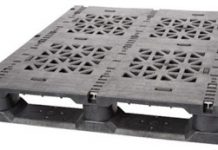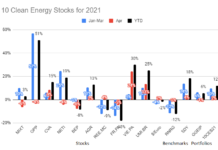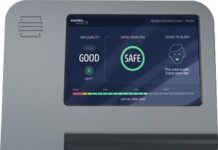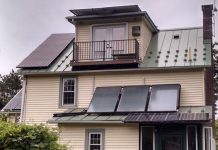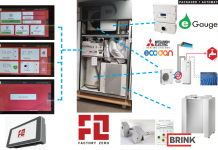Tom Konrad, CFA
A reader caught my attention with his description of Pure Technologies (PUR.V, PPEHF.PK), a company that can find leaks in water systems without shutting down the system. Since I was intrigued, I thought my readers might be as well. Here’s what he has to say. I’ve asked him to monitor the comments if you have follow-up questions of your own.
Tom Konrad: Tell us a little about yourself and your involvement in environmental investing.
Sam Healey: I invest largely in the cleantech sector. I look for companies solving problems that already exist, rather than companies attempting to create new markets. I’m particularly focused on energy technologies and conservation. I see a lot of money going into new systems when the cheaper and more effective use of those same dollars would be to improve the existing systems.
TK: You contacted me regarding a water leak detection company that I found interesting. Which is it, and why do you think that company would be interesting to my readers?
SH: The company is Pure Technologies out of Calgary, it trades on the TSX venture exchange under the ticker PUR.V or by extension as PPEHF on the pink sheets. It is a closely held business at this time, run essentially by two brothers, Peter Paulson who heads the R&D and is the CEO, and his brother James who is the chairman and face of the company. They have never sold a share, but have offered some of their holdings as part of the green shoe associated with the secondary offering just completed.
Pure Technologies has its roots in the structure monitoring businesses, primarily bridges and large buildings. The technology enables them to see weakness in the structures before they fail, thus avoiding disaster. They still participate in this market to the tune of 20-25% of their current revenue. However, their technology is also capable of monitoring the water infrastructure systems, . That is the direction they are now heading. They address the market in two ways. The first is through product sales. The main product they sell is a leak detecting system called the smart ball which they can send through water pipes without taking the pipes out of service. In 2009 they made an acquisition of a new robotic technology that will let them bring a similar service to the waste water market.
The other part of the business is the inspecting, consulting and monitoring business, which generates the majority of their recurring revenue is. With their technology, which they call Soundprint AFO and P-Wave electromagnetics, they lay fiber cable into a pipe which can take a snap shot of the pipe to find weak spots (P wave) or can continually monitor the integrity of the pipe (Soundprint AFO) so that weak sections can be identified and breaks can be prevented before they occur. Current World Bank estimates are that 45MM cubic meters of water are lost a day through leaks, and they estimate the total cost to water utilities by water loss at more than 14 Billion dollars. So I would say these products meet a large addressable and identifiable market.
TK: Why do they have such strong revenue visibility, and what revenue growth do you expect?
SH: They have the advantage that one product ends up creating a market for the other product. Smart ball serves as a wonderful introduction for the monitoring business. Smart ball demonstrations projects almost always result in orders. The fact that the Smart ball can do its work without taking the pipe out of service makes it very attractive. Most water systems have leaks, and finding them without discontinuing service is very attractive. Smart ball then provides the introduction of the Pure team and its P wave products and monitoring business. Often these products are sold into large multi year projects that have large recurring revenues, leading to a high level of visibility for annual revenue. Despite seasonality and lumpiness on a quarterly basis, annually I believe they feel confident in their projections. As far as revenue growth, I forecast 30 MM in 2009, 40 MM in 2010 and north of 50 in 2011. I’m hopeful that the recurring revenue portion will increase as a share of total revenue over that same period.
TK: What’s their profitability?
SH: Pure has reported profits for the last two years and 2009 will be no exception. I estimate the potential of 3MM in EBIT (in US dollars, they report in C$’s) in 2009 increasing to an optimistic number of 6MM in 2010. Current share count in about 33MM increasing to 40 MM with the recent secondary offering, so you can do the math. However these numbers are subject to exchange rate (forex) adjustments because they report in Canadian dollars which will hurt them in 2009. In 2009 the forex adjustment will be over a negative number of over 1 MM which will hurt the final reported EPS However, the 2009 forex loss will essentially result in reversing a 2008 forex gain. The revenue level is not high enough to justify an aggressive hedging program, especially considering that their revenues are global and so many currencies would be involved. Because I generally focus on the business and its development rather than forex effects I prefer to look at the EBIT per share which effectively smooths out forex adjustments rather than the lumpy EPS. By this metric the company is executing very well, a trend I expect to continue.
TK: How is the company funding its operations?
SH: For the last several years they have funded themselves with cash flow from operations, however in order to continue to expand their reach globally and add a few tuck in acquisitions they have announced and are in the process of closing (on February 23rd) a secondary offering for C$30MM.
This is a perfect example of “raising money for the right reasons”, they are producing cash flow already, and the proceeds from the offering will be directed at further geographical expansion and tuck in acquisitions. Associated with this transaction may be a move to a bigger exchange in Canada. They meet all of the listing requirement presently but have not made the move. One of the issues with the stock is that it is very illiquid. To the extent that moving to bigger exchange in Canada resulted in a larger daily trading volume, I would consider it a positive for investors and potential investors. Moving would allow them to potentially be included in some of the water indexes. At this point I am not aware of any potential listing on a US exchange.
TK: Do you have a price target for the company?
SH: For now I would say $7.00 US but this is very much a moving target. I think the 7$ is reasonable for the projects they have solid viability on right now. For example, in 2009 the recurring revenue piece of the business will be in the 3.5MM range. The project they have in Libya will net 5 MM recurring revenue in 2011 by itself. As each of the current projects ramps up they achieve higher levels of profitability 7 dollars seems about right. However, with the recent robotics acquisition enabling them to move into waste water systems monitoring and the expansion into South America and East Asia just beginning, I am hopeful that I will find myself raising the target before we get to it. That will depend entirely on execution going forward.
TK: How competitive is the leak detecting space? Are there any competitors with similar products?
SH: Leak detection is a competitive space in the sense that it is a major problem for all water and wastewater systems. However I am unaware of anybody that has the technology to address these problems without taking the lines out of service. I am also not aware of anyone competing in the pipe monitoring business with a comparable technology.
TK: How dependent is Pure Technologies on a growing economy?
SH: I would say it isn’t. In the emerging markets the growth is such that need for water and leak detections system is massive and Pure has gained considerable traction in emerging markets. Pure’s customers are generally utilities or governments, so they are not dependent on consumer spending. Moving into the realm of speculation, I’d guess that difficulties in the ability of utilities and municipalities to float bonds for spending on water system projects could potentially hurt business. That said, I expect 2009 revenue to be double 2007 revenue, despite the interim lack of economic growth.
TK: Do you own shares of the company in your fund or your own account?
SH: I own shares of the company in my fund.
TK: Thanks for sharing your research. Water and energy are intimately linked, but I hesitate to spread myself into more areas than I already have.
SH: It’s been a pleasure.
DISCLOSURE: None, but I’m considering buying.
DISCLAIMER: The information and trades provided here and in the comments are for informational purposes only and are not a solicitation to buy or sell any of these securities. Investing involves substantial risk and you should evaluate your own risk levels before you make any investment. Past results are not an indication of future performance. Please take the time to read the full disclaimer here.


